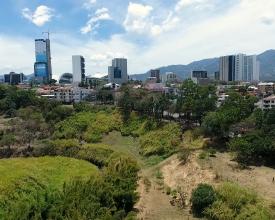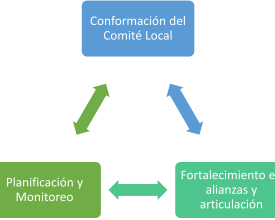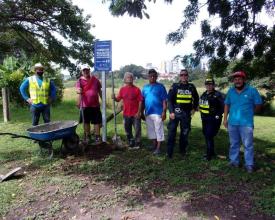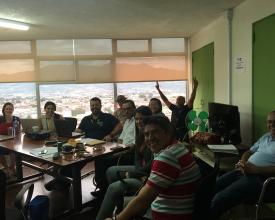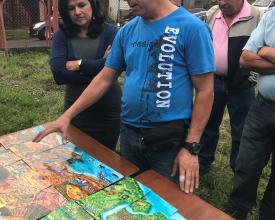
Interurban Biological Corridors: Mechanisms of participatory local governance for sustainability in cities.
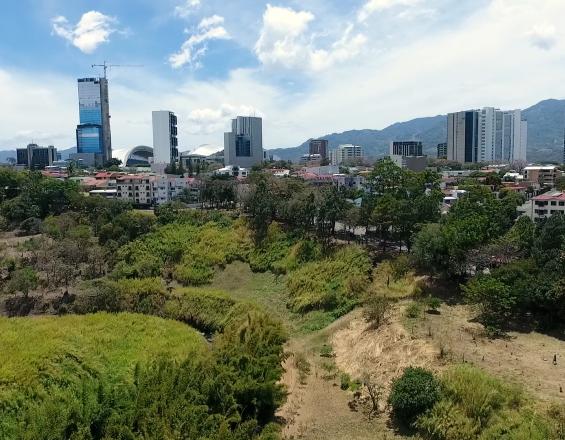
Interurban Biological Corridors (IBC) are participatory conservation strategies that seek to improve environmental conditions in cities, generally near rivers or streams that run through them. The basis of the CBI is the Local Committee (LC), an organized group of people representing different political, institutional, social, and economic sectors, among others, to channel technical and financial resources to the CBI. This makes possible the creation of alliances between all those interested in implementing initiatives that integrate economic, environmental and social aspects to increase ecological connectivity, resilience and wellbeing in cities through the increase of green areas, providing a better quality of life for the people who live there.
Context
Challenges addressed
To recover protected areas invaded by the expansion of cities and productive activities, pollution, habitat destruction and loss of green spaces along rivers and other areas that provide benefits to the urban population (e.g. drinking water supply), alliances are formed with public entities, companies and organizations to promote and finance sustainable local initiatives. Socio-environmental/economic conflicts in CBI regions are resolved through integrated territorial management, coordinated decisions, communication and information dissemination. The CL as a space for coordinating articulated measures of corporate social responsibility is a local strategy for investing inputs in the CBI territory, which is interesting for the private sector as it maximizes the benefits generated with its contributions. The participation of economic actors in spaces for dialogue and articulation encourages innovation and learning in productive processes, seeking sustainable alternatives.
Location
Process
Summary of the process
It is favorable for the proper functioning of the CBI to think of a constant relationship between the BBs: processes such as capacity building, planning, monitoring and continuous improvement of the strategies implemented are closely linked to the management of internal and external partnerships, allowing the gathering of information, as well as the flow and adoption of new knowledge, experiences and lessons learned. On the other hand, partnerships make it possible to implement strategies and measures with an impact on the territory, thus justifying the existence of the CBI. Capacity building ensures that the CL is formally constituted as a platform for intersectoral articulation and that members are able to adjust their processes and structures to changing social, political-administrative and environmental conditions. At the same time, the articulation between economic and political sectors of the zone and the capacities in the creation of alliances with different entities and actors work to obtain inputs and develop ecologically important projects in urban areas.
Building Blocks
Formation of a Local Committee for stakeholder representation in the CBI.
The Local Committee (LC) begins its formation with a group of people who share a common interest in the same territory. It defines the name of the CBI and its geographic limits, the way it will work, what rules it must follow internally and with what objective the corridor is formed. It can work in the form of an association, alliance, executive or support committee, management group, technical coalition, among others. In its formation process it is recommended to have at least one community leader, representation of local governments of the CBI territory, an NGO or non-profit organization, a representative of the productive or private sector and an institutional representative, who together will be responsible for managing alliances and facilitating the contribution of other actors interested in promoting technical and financial resources in their territory. The representativeness of the different sectors (public, private, academic, civil, etc.) is essential for the success of the CBIs, since they contribute with their knowledge and capacities for the adequate logistics of the CBIs, facilitate the discussion among all the representatives and provide different points of view so that the decision making is integral, from broad perspectives and echoes what happens in the management of the CBI in the communities and institutions that comprise it.
Enabling factors
- Prioritizing existing environmental legislation and policies allows for the justification of the CBI and increases the commitment to participation of public institutions.
- The co-participation of political administration entities and governing bodies of natural resources and associated services in the region (water, soils, forests, commerce, health, security) is fundamental for dialogue and articulation to lead to decisions and commitments that meet the needs of all involved.
Lesson learned
- LCs should be seen as extended governance systems of coordination and leadership.
- A detailed diagnosis as a starting point is essential to become familiar with the territory, the inhabitants, their capacities and needs.
- The mapping of local actors is very valuable to define who can be strategically integrated into the LC.
- The initiative to form a CBI can come from an institutional actor or from the productive sector and be equally successful as when it comes from the community.
- The projects proposed by the LC for the CBI territory should be interdisciplinary, so that representatives of different entities can contribute their knowledge and resources to the proposal.
- Having 2 or more delegates (representatives) from the same organization is favorable, since it allows having a wide participation in case of absences in work sessions and/or trainings. Whoever attends, contributes as a representative of the organization and then shares the information in the institution to which he/she belongs.
Strategic planning and management monitoring of the Interurban Biological Corridor.
The strategic planning of a CBI is the basis for defining how the objectives will be met, with which organizations and institutions of the territory alliances should be formed, how financing will be obtained for the projects to be executed, what legislation supports the management of the corridor, who will be in charge of the coordination and leadership of the actions to increase and improve the green spaces of the cities.
Monitoring of CBI tasks and progress should be recorded to evaluate the implementation of CBI plans and take corrective action if there are opportunities for improvement. These steps maintain efficient functioning of the CBI and orderly conduct of the CL dialogue. Progress towards the achievement of goals and objectives in the medium and long term maintains the interest of the participating actors and their permanence in the spaces for dialogue and articulation.
Planning and monitoring should be systematized through the registration of participants, sessions, training, activities, projects and results, in order to transmit information transparently to all members of the CBI. In the medium and long term, knowledge bases are obtained to carry out research, make better decisions for land management and greater functional ecological connectivity.
Enabling factors
- To ensure the smooth development of the strategic planning process, it is necessary to communicate assertively, reconcile interests and desired results, and reach an agreement that includes the participants to be convened, deadlines and time to be invested, methods and tools to be used, work session formats, and rules on product review and approval. Technical dialogue among all parties is essential to achieve the strategies outlined in the CBI planning.
Lesson learned
- For efficient planning and adequate monitoring, it is recommended to hold joint and periodic working sessions, at least quarterly.
- Assertive communication and transparent reporting within the LC is essential to ensure that the interests of all participating groups are expressed respectfully and taken into account for efficient planning.
- All resources available to Local Committee participants (financial, intellectual, human, academic and technical) can be leveraged if strategically negotiated.
- Participatory planning methodologies are a good way to gather perspectives, needs, opportunities and available resources, which speeds up the subsequent implementation of planned actions.
- The establishment of agreed indicators to monitor CBI progress facilitates the identification of opportunities for improvement.
Capacity building in internal/external partnerships and articulation
Capacity building in the creation of alliances and the articulation between the different organizations that make up the CL of a CBI are essential for the efficient execution of measures aimed at improving the environmental conditions of the territory. This will be composed of people with different professions, vocations, levels of knowledge and experience. It is important to offer spaces to train them on topics underlying the actions of an IWC: ecology fundamentals, conservation concepts, current regulations, political-administrative processes, etc. A common understanding of these bases will create a better environment for internal collaboration and cooperation. When developing strategies and action plans for the territory, the limited resources available will make it necessary to seek contributions from third parties: research, project financing, articulation of CBI measures with municipal management instruments, and transfer of knowledge and technology. This external articulation can only be successful through coordination and collaboration with other entities in the territory, CBI members should be instructed and trained in methods and good practices for the creation of intersectoral alliances, and regularly exchange lessons learned.
Enabling factors
- Multilevel and interdisciplinary coordination favors articulation in all directions and assertive relationships in the CBI territory. To this end, it is essential to develop a strategy based on detailed stakeholder mapping.
- Partnerships with the private sector make it possible to obtain fresh goods and resources for the implementation of measures in the territory; they also encourage other actors to become part of the CL.
- The articulation with academia facilitates resources to develop social and environmental projects and research in the CBI.
Lesson learned
- The communities in the territory of the CBIs are fundamental actors for the implementation of concrete measures. To this end, it is necessary to identify and create alliances with community leaders and spokespersons. At the beginning, a reasonable amount of time should be allowed to establish a relationship of trust.
- When incorporating new actors as members or allies of the CBI, it is important to recognize and respect the roles and responsibilities previously established, as well as the dynamics and organizational levels of the CBI.
- The training provided by the CBIs can be open to the general public, so that all sectors can take advantage of them and facilitate the exchange of knowledge and information among the actors. In addition, it provides visibility to the CBI and a space to promote the achievements and impacts of the work of the CL.
Impacts
The management of CBI generates or increases green areas, allowing flora and fauna species living in or near cities to transit, obtain habitat, food and shelter in sufficient quantity and quality for their healthy development. In this way, genetic exchange between them (biological connectivity) is encouraged, favoring biodiversity and increasing the quality of Urban Ecosystem Services. The inhabitants of the cities benefit from the improvement in the environmental conditions of their territories and obtain a better quality of life. The CBIs favor the participatory governance of cities, integrating different actors through the CLs and strengthening the work in interdisciplinary teams with alliances between civil society, municipal governments, state institutions of the environmental sector, public and private companies, NGOs, regulatory entities of resources and services, in order to coordinate efforts, carry out initiatives for the solution of socio-environmental problems generated by the uncontrolled expansion of cities and meet the needs in an integral and inclusive manner for all sectors of society. In the long term, the CBIs promote an efficient and orderly society, capable of making agreements and conscious decisions about the importance of biodiversity conservation as a transversal axis in the management of their territories.
Beneficiaries
IWC communities: Río Torres Biosphere Reserve, Río María Aguilar, Rivereño Interurbano Subcuenca Reventado Aguacaliente, El Achiote, Pará-Toyopán, Garcimuñoz, and Tiribí. 2.6 million inhabitants.
Sustainable Development Goals
Story
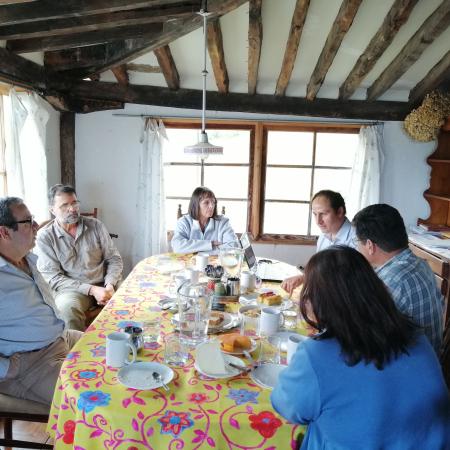
In order to take action in a CBI, it is first necessary to recognize the environmental problem, the situation of the populations of the territory where the corridor is to be delimited, and the capacities of the Local Committee (LC) of the corridor. Such is the case of the Río Torres Biosphere Reserve CBI, which began with the recognition of the difficulties of the cantons it crosses: San José, Goicoechea, Montes de Oca and Tibás in Costa Rica. Thus, it became the first urban ecotourism circuit with trails linked by green areas where you can watch birds, buy organic food and support the local economy of these cantons with action plans that include environmental communication and education, preparation of nurseries, restoration and reforestation, with the help of alliances that they have managed since its creation in 2017, always seeking that participation in the CL is balanced between civil society and the public/private sector.
Another case is the Interurban Riverine Biological Corridor Interurban Sub-basin Reventado Aguacaliente with the project "Holistic Pasture Management as an alternative to recover the productive capacity of the soil and natural balances" in which Hacienda Retes (206 ha), Finca Ganadería Nueva Prusia (37 ha) and Finca El Zanjón (17 ha) participated. Thanks to this small project in its beginnings, new initiatives emerged and were replicated until bringing positive economic and environmental results due to Good Agricultural Practices that reduced livestock feed and medicine inputs and increased dairy profits from 1.28 % in 2018 and up to 12.22 % in 2020. The presence of 66 species of avifauna and 6 families of mammals catalogued as species with special conservation status was reported. Coordination between the Universidad Nacional de Costa Rica, the Colegio Universitario de Cartago, the Lycée Agricole Edgar Faure, as the academy that provided the data recording and part of the systematization of the experience, state institutions, and the National University of Costa Rica was essential. The monitoring of species was made possible by the coordination of state institutions such as the Ministry of Environment and Energy (MINAE) and the National System of Conservation Areas (SINAC), together with the National Institute for Innovation and Transfer of Agricultural Technology (INTA), which provided technical and material support; and the Friends of the Model Forest Foundation (FUNDABOSQUE), which supported the management and promotion of the process, as well as the dissemination of information.
